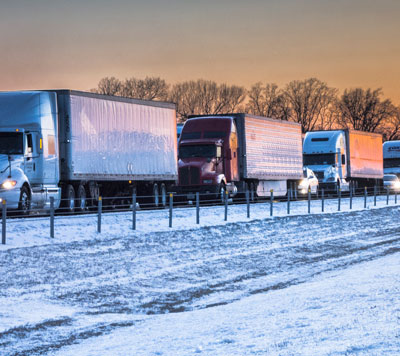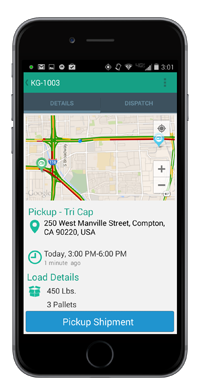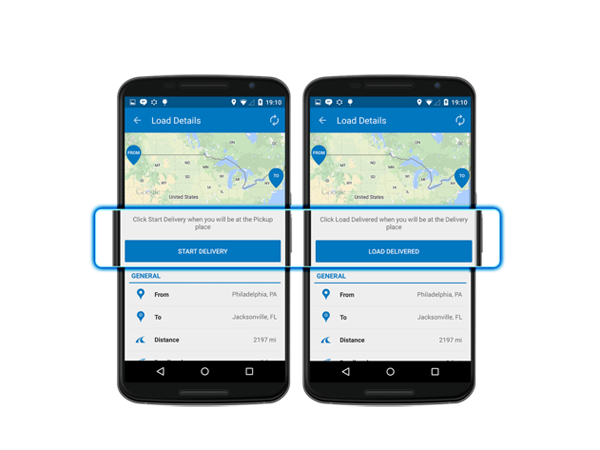Uber for Trucking: Matching Freight with Haulers
New Technology Aims to Reduce Number of Empty Trucks on Roadways

Kent Kobersteen/National Geographic Creative/CorbisHandwritten notes on bulletin boards at truck stops were once a principal means that shippers with goods to haul and willing truck drivers found each other. Then in a groundbreaking move, Dial-A-Truck in 1978 installed television monitors in truck stops to post trucker and shipper notices.
Today, finding freight to haul – or truckers to move merchandise – is as easy as logging into one of many smartphone applications on the market. There are several companies offering so-called “Uber for trucking” applications that match drivers with available freight.
While there is a lot of variety and the applications differ widely, they all aim to do the same thing – reduce the number of mostly empty trucks travelling the roadways.
Dial-A-Truck, now DAT Solutions, used to make money by charging truck drivers a fee in exchange for the number of the company posted on its truck stop TV monitors looking to move its freight.
Now the company has replaced thousands of those monitors – known as load boards – with mobile applications that can pinpoint a driver’s location and offer a series of services.
“Now our technology uses the location in the phone to find them fuel, food and lodging and extract freight loads from our commercial load board,” said Greg Sikes, vice president of product management at DAT Solutions. “They can pursue one, two or three of those loads as they want. We may be old, but we’re not stodgy.”
DAT Solutions’ applications include TruckersEdge, which offers unlimited load searching and posting and also contains information about weather and road conditions; and MyDAT Trucker, which can find nearby lodging and truck scales among otherservices. And DAT Solutions isn’t alone.

Cargomatic
Los Angeles-based Cargomatic works to
connect shippers to truck drivers with
excess capacity.
There’s Cargomatic, which aims to meet shipping needs for shorter distances in metropolitan areas; Traansmission, which works with mid-market brokers; and Trucker Path, which is developing a new application to match shippers and carriers for longer-hauls.
The spot market, through which pick-ups and deliveries are generally scheduled as one-time events rather than recurring contracts, is expanding. Smaller carriers, including independent drivers who own the trucks they drive, are also making more “last mile” trips to transport goods on the last leg of a journey.
But despite the rapid growth in trucking applications in recent years, there hasn’t been a major impact on companies that have been matching haulers and freight for generations.
“They aren’t going to disrupt the marketplace. There’s plenty of room,” said Bob Voltmann, president and CEO of the Transportation Intermediaries Association (TIA), an organization that represents third-party logistics companies.
Voltmann said as individuals and businesses are increasingly requiring delivery of goods and equipment, the need for carrier space is growing at a rate of two to three times America’s gross domestic product.
“More and more shippers are turning their transport needs to third parties,” Voltmann said. “There’s no commonality. Truck freight ranges from a shoe box to a drilling pipe.”
While the Owner-Operator Independent Drivers’ Association also doesn’t see these smart phone applications changing the industry, it has encouraged members to consider using the technology. But Norita Taylor, OOIDA’s director of public relations and marketing, said the association hasn’t yet received feedback from any members using such applications.
The companies behind these new applications say there is a need and a place for them in the market.
For example, Jason Cahill, co-founded and CEO of Traansmission, said he works primarily with mid-market brokers who “don’t have technology or knowledge to build their own assets,”
“We are a technology platform that allows you to post a load once and have your entire fleet see it instantly,” he said.
Cargomatic, founded three years ago in Los Angeles, has also seen a need for its services and has expanded operations to New York, New Jersey and the San Francisco bay area. Brett Parker, co-founder and president of Cargomatic, said his clients include retailer Williams-Sonoma, e-commerce giant Amazon and SpaceX, an aerospace manufacturer.
And the company is looking at other ways to improve freight movement. In the Los Angeles area, Cargomatic implemented a process called peel off, a method of organizing containers together at the port that will ultimately travel to the same destination to expedite truck pickups.

Trucker Path
Trucker Path, launched in 2013, has an app for drivers and shippers who want to move goods across states.
For drivers and shippers who want to move goods across states, Trucker Path – which launched a self-named app in 2013 that helps carriers find and review information about routes, rest areas and other resources – is piloting a new application for longer hauls called Truckloads.
Charles Myers, Trucker Path’s vice president of strategy , said there were 200 to 250 truckers testing a beta version of Truckloads and providing feedback last year. Since the application went live, it now has 5,000 weekly active users. And the company is exploring an international expansion to bring and carry loads to the United States from China and Brazil.
Trucker Path is also working on a closed-loop marketplace app where users of the system, including brokers, can rate one another.
Industry mainstays, like DAT Solutions, acknowledge there is a niche for these new companies.
Ken Harper, director of marketing at DAT, said most new startups creating trucking apps are focused on local or regional-bound freight with shorter delivery times and smaller trucks.
“We really think these smaller companies are going to have success regionally,” Harper said. “But when you get into interstate trucking, which is sort of our bread and butter, the industry changes.”
Sikes, the vice president of product management at DAT, said that size matters for these longer hauls. He said DAT enters 120 million loads at a time into its system and has a network of about 1 million available trucks.
“To succeed in this business, you need critical mass,” he said. “Carriers want one thing, loads. Brokers want trucks.”
Sikes said the vetting process and having a level of trust between parties is also very important.
Whether trucking apps are being created by longtime players or recent startups, mobile technology is helping the industry as a whole.
Harper noted that the polar vortex in 2014 slowed the market, causing 40 percent of freight to be moved on the spot market. The apps helped the jobs get posted and completed quickly. This was critical not only for shippers, brokers and carriers, but also consumers.
“If the freight is perishable and doesn’t move in a day or two, it can get ruined,” Harper said “(Load boards) are like an insurance policy if your contracted carrier can’t move. Your stores can’t go empty.”
Voltmann said apps are also helping meet the public’s demand for immediate delivery. Many retailers are in the process of building new distribution centers within and just outside of metropolitan areas.
“Amazon has conditioned us to want our products in two days to an hour. This means we need more last-mile drivers,” he said.
Since last-mile drivers can include owners of vans and sedans, the apps enable more loads to be delivered without requiring a commercial driver’s license (CDL). Employing drivers without CDLs helps an industry facing a shortage of certified drivers.
This rapid growth in the number of smart phone applications for freight hauling is attributed to the spike in truck drivers using smart phones. The shift has been drastic.
“Sixty percent of drivers use smartphones now, as opposed to 20 percent three years ago,” Harper said.
Myers, who has been in the trucking business for close to 40 years, said he estimates the number of drivers using smart phones at closer to 90 percent.
“It just shows you that truckers are transitioning and really starting to grasp the technology,” said Myers. “Once they’re using the apps, it’s not hard.”
Jessica Zimmer is a freelance writer based in California.
This article has been updated to include more recent information about Trucker Path's application, which was in the testing phase when this story was being reported. The application has since gone live and has 5,000 weekly active users.